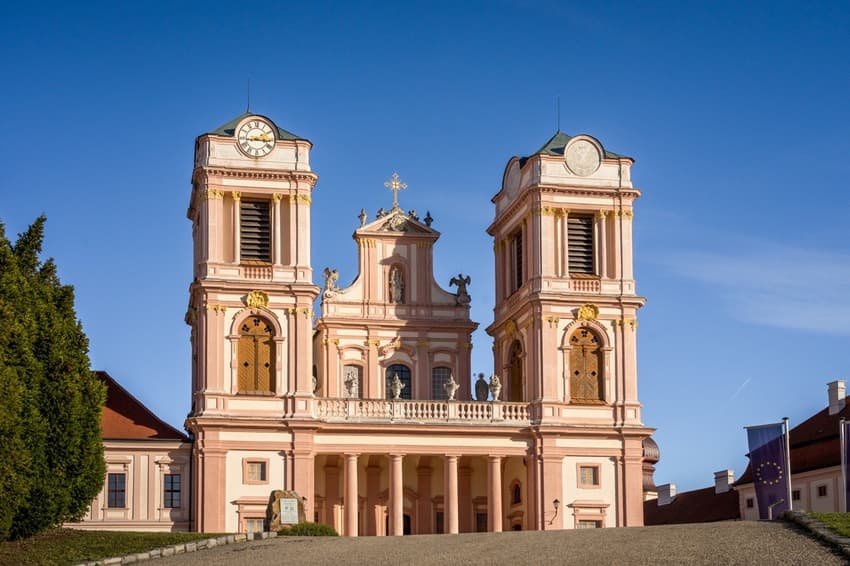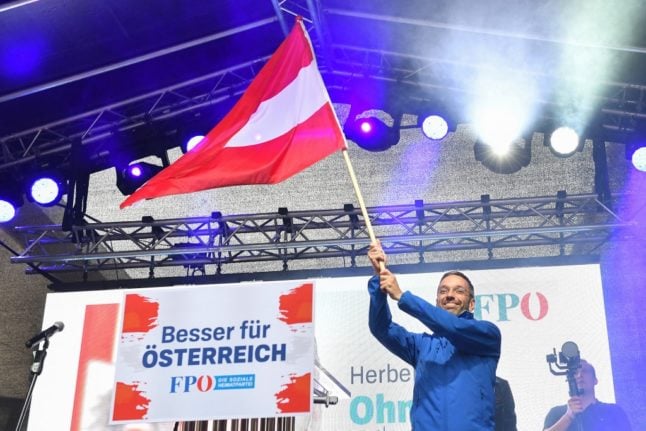Five things you need to know about the Lower Austria elections

One of Austria's most populous provinces is set to choose a new government this Sunday. But why does that matter?
Austria is heading into one of its most significant elections as Lower Austria (Niederösterreich) heads to the polls on Sunday, January 29th, to elect a new regional parliament.
Current governor Johanna Mikl-Leitner (ÖVP) is seeking reelection, but her party, the centre-right ÖVP, has dropped on voting intention polls.
According to an OGM/Kurier poll from January 21st, the regional ÖVP party, known as VPNÖ, leads the race with 37 percent of voting intentions - far from the majority it would need to govern without a coalition.
Then, the far-right party FPÖ follows with 26 percent of the votes. Next is the centre-left SPÖ with 23 percent, the liberal NEOS with 7 percent and the Greens with 6 percent.
NIEDERÖSTERREICH | Sonntagsfrage Landtagswahl OGM/Kurier
VPNÖ: 37% (-5)
FPÖ: 26% (+11)
SPÖ: 23% (+1)
NEOS: 7% (+1)
GRÜNE: 6% (-2)
Sonstige: 1% (-6)
Änderungen zur letzten Umfrage vom 08. Mai 2022
Verlauf: https://t.co/zCC0U1xvRv#ltwnoe pic.twitter.com/Qjbfe8XdTL
— Österreich Wählt (@Wahlen_AT) January 21, 2023
The country has its eyes on this election. But why is it so important and what do you need to know about it?
Lower Austria is a prominent Austrian province
Firstly, Lower Austria is a very significant Austrian province. It's the second-most populous state in Austria after the capital - it is also the largest state by area. Furthermore, the region surrounds Vienna and many workers in the capital live in nearby cities, as Lower Austria has dozens of commuter towns.
The state capital is Sankt Pölten, and other major cities include Wiener Neustadt, Amstetten, Klosterneuburg, Krems an der Donau and Stockerau.
READ ALSO: Can the Austrian president refuse to appoint a far-right chancellor?
Historical loss for the ÖVP predicted
To say that the state is a stronghold of the centre-right political party ÖVP, the Austrian People's Party, is an understatement. The ÖVP has been ahead of the provincial government (and of much of its municipalities) ever since the war. Moreover, it currently holds a majority in the regional parliament, meaning that it rules without the need for a coalition partner.
But things are about to change. Voting intention polls show that the ÖVP will most likely lose its majority in Lower Austria, a testament to the plummeting popularity of the centre-right party.
From the around 50 percent of votes which gave it 29 seats in parliament, the party is now polling at 37 percent.
READ ALSO: EXPLAINED: How do Austrians elect their chancellor?
Not only does that mean Austria will likely see a historical coalition talk taking place in the state, but Lower Austria is also responsible for a large part of the votes that the ÖVP gets in federal elections.
Losing those voters locally might mean a big upset ahead in the National Council, and the parties all know it, with all of the major ones fighting to get voters.
... and a historical win for the FPÖ
At the same time as the ÖVP drops in voter preference, the far-right party FPÖ, known as the Freedom Party, is rising. In the last local elections in 2018, they received 14.8 percent of the votes but now are polling in second place, with 26 percent.

The leader of the FPÖ and former Austrian Interior Minister Herbert Kickl waves the Austrian flag. (Photo by JOE KLAMAR / AFP)
This mirrors a federal rise by the FPÖ, which now polls in first when citizens are asked who they'd vote for in the parliamentary elections. The rise of the far-right is down to many reasons, from its stance on polarising topics such as the Covid-19 pandemic to criticism over the government's actions regarding the inflation crisis and migration.
READ ALSO: Why is support for Austria’s far-right FPÖ rising?
In Lower Austria, surveys show that citizens are concerned about inflation, climate crisis, and asylum and immigration, many topics where the raging FPÖ speech thrives.
The election could be seen as an early national vote
Lower Austria is relevant geographically, economically and culturally. With its enormous population, results in the state are often seen as a preview or at least a taste of what's to come in federal elections.
And Austria is set to have its next parliamentary elections in the Autumn of 2024, so all eyes are now on Lower Austria.
READ ALSO: Reader question: Will my children get an Austrian passport if born in Austria?
Just as voting intention polls show ÖVP dropping and the FPÖ rising in the federal scenario, the same is seen in the province. Austrian politicians and analysts are watching closely to see how exactly the polls translate to actual votes, how this will influence coalition talks and what a new government will look like there.
Foreigners are still excluded from the democratic process
Something else you should know about the Lower Austrian elections: foreigners are excluded from the democratic process.
The only people who are eligible to vote, according to the government, are those who:
- are at least 16 years old on election day, January 29th 2023, and
- on the cut-off date, November 18th, 2022: have Austrian citizenship, have their main place of residence in Lower Austria or are Austrians living abroad who had their last main place of residence in Lower Austria before their stay abroad, and are not excluded from the right to vote due to a court conviction
Foreign residents of Lower Austria, even those with a main residence there for decades and who pay their taxes there, cannot vote in the state elections.
READ ALSO: Reader question: Can I vote in Austria’s presidential elections?
Comments
See Also
Austria is heading into one of its most significant elections as Lower Austria (Niederösterreich) heads to the polls on Sunday, January 29th, to elect a new regional parliament.
Current governor Johanna Mikl-Leitner (ÖVP) is seeking reelection, but her party, the centre-right ÖVP, has dropped on voting intention polls.
According to an OGM/Kurier poll from January 21st, the regional ÖVP party, known as VPNÖ, leads the race with 37 percent of voting intentions - far from the majority it would need to govern without a coalition.
Then, the far-right party FPÖ follows with 26 percent of the votes. Next is the centre-left SPÖ with 23 percent, the liberal NEOS with 7 percent and the Greens with 6 percent.
NIEDERÖSTERREICH | Sonntagsfrage Landtagswahl OGM/Kurier
— Österreich Wählt (@Wahlen_AT) January 21, 2023
VPNÖ: 37% (-5)
FPÖ: 26% (+11)
SPÖ: 23% (+1)
NEOS: 7% (+1)
GRÜNE: 6% (-2)
Sonstige: 1% (-6)
Änderungen zur letzten Umfrage vom 08. Mai 2022
Verlauf: https://t.co/zCC0U1xvRv#ltwnoe pic.twitter.com/Qjbfe8XdTL
The country has its eyes on this election. But why is it so important and what do you need to know about it?
Lower Austria is a prominent Austrian province
Firstly, Lower Austria is a very significant Austrian province. It's the second-most populous state in Austria after the capital - it is also the largest state by area. Furthermore, the region surrounds Vienna and many workers in the capital live in nearby cities, as Lower Austria has dozens of commuter towns.
The state capital is Sankt Pölten, and other major cities include Wiener Neustadt, Amstetten, Klosterneuburg, Krems an der Donau and Stockerau.
READ ALSO: Can the Austrian president refuse to appoint a far-right chancellor?
Historical loss for the ÖVP predicted
To say that the state is a stronghold of the centre-right political party ÖVP, the Austrian People's Party, is an understatement. The ÖVP has been ahead of the provincial government (and of much of its municipalities) ever since the war. Moreover, it currently holds a majority in the regional parliament, meaning that it rules without the need for a coalition partner.
But things are about to change. Voting intention polls show that the ÖVP will most likely lose its majority in Lower Austria, a testament to the plummeting popularity of the centre-right party.
From the around 50 percent of votes which gave it 29 seats in parliament, the party is now polling at 37 percent.
READ ALSO: EXPLAINED: How do Austrians elect their chancellor?
Not only does that mean Austria will likely see a historical coalition talk taking place in the state, but Lower Austria is also responsible for a large part of the votes that the ÖVP gets in federal elections.
Losing those voters locally might mean a big upset ahead in the National Council, and the parties all know it, with all of the major ones fighting to get voters.
... and a historical win for the FPÖ
At the same time as the ÖVP drops in voter preference, the far-right party FPÖ, known as the Freedom Party, is rising. In the last local elections in 2018, they received 14.8 percent of the votes but now are polling in second place, with 26 percent.

This mirrors a federal rise by the FPÖ, which now polls in first when citizens are asked who they'd vote for in the parliamentary elections. The rise of the far-right is down to many reasons, from its stance on polarising topics such as the Covid-19 pandemic to criticism over the government's actions regarding the inflation crisis and migration.
READ ALSO: Why is support for Austria’s far-right FPÖ rising?
In Lower Austria, surveys show that citizens are concerned about inflation, climate crisis, and asylum and immigration, many topics where the raging FPÖ speech thrives.
The election could be seen as an early national vote
Lower Austria is relevant geographically, economically and culturally. With its enormous population, results in the state are often seen as a preview or at least a taste of what's to come in federal elections.
And Austria is set to have its next parliamentary elections in the Autumn of 2024, so all eyes are now on Lower Austria.
READ ALSO: Reader question: Will my children get an Austrian passport if born in Austria?
Just as voting intention polls show ÖVP dropping and the FPÖ rising in the federal scenario, the same is seen in the province. Austrian politicians and analysts are watching closely to see how exactly the polls translate to actual votes, how this will influence coalition talks and what a new government will look like there.
Foreigners are still excluded from the democratic process
Something else you should know about the Lower Austrian elections: foreigners are excluded from the democratic process.
The only people who are eligible to vote, according to the government, are those who:
- are at least 16 years old on election day, January 29th 2023, and
- on the cut-off date, November 18th, 2022: have Austrian citizenship, have their main place of residence in Lower Austria or are Austrians living abroad who had their last main place of residence in Lower Austria before their stay abroad, and are not excluded from the right to vote due to a court conviction
Foreign residents of Lower Austria, even those with a main residence there for decades and who pay their taxes there, cannot vote in the state elections.
READ ALSO: Reader question: Can I vote in Austria’s presidential elections?
Join the conversation in our comments section below. Share your own views and experience and if you have a question or suggestion for our journalists then email us at [email protected].
Please keep comments civil, constructive and on topic – and make sure to read our terms of use before getting involved.
Please log in here to leave a comment.